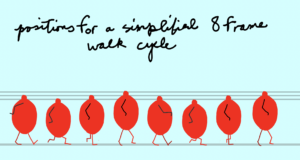Walk cycles
This week we will tackle the walk cycle: a looping cycle of your character walking. Creating a smooth and satisfying animated walk takes time and practice. Different walks will have different key poses and number of frames, but we’ll start with a pretty standard walk – assured, neither rushed nor slow. We will start with the legs and add the arms afterwards to keep things simple.
Key poses
Let’s break down the walk cycle into different key poses. We’ll start with:
- The contact pose: one foot is firmly on the ground, the other has just landed (usually with the heel first)
- The passing pose: the foot passes the one that was previously in front of it.


If you repeat and inverse these two poses, you get a choppy but physically sound walk cycle.

Walk cycle with just contact and passing poses (4 frames)
Next, we add two more key poses:

- The down pose (after the contact pose): the head is at its lowest in the cycle because the leg that just landed on the previous frame is now bent.
- The up pose (after the passing pose): the head is at its highest in the cycle because the leg that was just passed is lifting on its toes to propel the character forward.


Adding the arms
The arms usually swing in the opposite direction as the leg (i.e: if the left leg is extended forward, the left leg will be swinging back).
Adjusting the timing
Once you have the 8 basic key poses ready, you can adjust the speed and timing of your walk by adding in-betweens and/or extending certain frames.
Mood
The way a character walks can say a lot about his personality and current state of mind. Small adjustments in the timing, position and offset of the basic walk cycle above can drastically change a walk’s emotional connotation. For a sad walk for example:
- Make the up and down poses closer in height to diminish the bounce effect
- Lean the body forward
- Droop the arms (no back and forth/offset)
- Make the contact and down poses longer than the pass and up poses.

References
You can use the example above as a reference, but you can also find a lot of examples online by doing a search for “walk cycle” (i.e: these variations by Preston Blair) (this video uses a slightly longer cycle than the one above – 12 vs. 8 frames – but it’s a good summary of the mechanics at play). Acting out your character’s walk and recording it can also be really helpful.

“Tutorial-2 : Walk Cycle.” Tutorial-2 : Walk Cycle |, www.angryanimator.com/word/2010/11/26/tutorial-2-walk-cycle/.
Don Bluth on animating a bird flying.
For the LinkedIn. Learning tutorials, you have to be. logged in to LinkedIn Learning. Use your BMCC user id and password.
Walk cycle basics on LinkedIn Learning
Animal walk cycles on LinkedIn Learning
Video Tutorials
Some videos I made on YouTube
Assignment:
Details here: Walk cycle 1
Checklist
- View the Alan Becker video on Walk cycles
- Looked at Preston Blair’s variations
- Completed a simplified walk cycle for your character in Animate and exported an animated gif
- Created a post on your OpenLab Portfolio with the gif and posted a link to the Walk Cycle 1 discussion board
- Posted the fla file to Blackboard along with the URL for the portfolio post